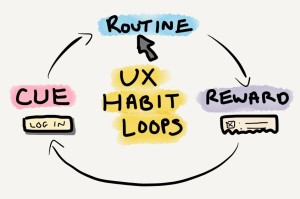hab·it [hab-it] noun
- an acquired behavior pattern regularly followed until it has become almost involuntary
In the book The Power of Habit, author Charles Duhigg explains how habits are formed and what it takes to break an ingrained habit. The book references a 2006 study from Duke University that found that 40% of the actions that people perform each day are habits, not purposeful decisions. Habits impact our daily lives in many different ways, even in how we interact with websites and applications. Being aware of how habits may influence interactions users have with your products can help you design better user experiences.
The Habit Loop
Duhigg breaks down how habits are formed into a very simple habit loop:
- A cue triggers your brain to respond in a certain way
- You respond by doing a routine or action, which could be physical, mental, or emotional
- A reward is given for doing the routine, telling your brain that the habit is worth repeating in the future
Digital Experience Habits
As users use a website or application repeatedly, they’re likely to start developing habits. Cues cause users to look to the same place repeatedly in order to access information or complete a task. If the user consistently repeats a behavior, it becomes almost automatic the next time they’re looking to perform the same action.
Users who frequently reference the same information within an online experience will usually learn the path that they need to take to access the content. They may focus more on where they remember these links to be on a page or screen rather than actively focusing on the logical pathways to get to the content. Think about an experienced cashier entering an order at a fast food restaurant. In order to be efficient, they’re likely to develop habits and rely on memory of where items are on the screen rather than focus on the actual content on the screen.
As another example, consider the account login experience for most websites and applications. If visibility and placement of an account login remains consistent, registered users may start to automatically access the login while ignoring everything else. Every time the user successfully logs in and gets to the information they were seeking (the “reward”), this habit is reinforced.
How to Identify Your Users’ Habits
- Conduct usability tests or contextual observation studies with existing users – Ask users to show you how they currently complete tasks or find information. Make note of the times when they habitually click on navigation elements or calls to action vs. when they exhibit browsing or searching behaviors to find what they’re looking for. This can help you identify the cues and routines that impact user behavior for common tasks.
- Review analytics – Review your analytics to identify the most common navigation paths that users follow to get to the top visited content. Try to identify if these paths remain consistent over time. While not a definite indication of habitual behavior, consistent activity trends can give you insight into whether users are typically accessing information in the same way over time.
Redesigns Can Disrupt User Habits
Repeat visitors learn over time where to go to access content, and these behaviors can become habits.
If content is moved, deleted, or modified in any way, it can be disorienting and frustrating for users who expect to find the content (the reward) based on their previous behaviors. Major redesigns can be especially disruptive to the user experience, even if the change is for the better. Recognize that a new interface may cause users to become disoriented and confused even for the most basic tasks. Users will need to change their habits in order to complete their old tasks.
Read more about the impact that big redesigns can have in Jared Spool’s article
Extraordinarily Radical Redesign Strategies.
How to Change User Habits
Duhigg identifies a relatively simple process for how to modify habits:
- Identify the cue that triggers the routine and the reward that the habit brings
- Actively replace the original routine associated with a cue and reward with a new routine
When it comes to digital experiences, this is easier said than done, as users can quickly get impatient and frustrated if they have to change their routines. You have a few options to try and reduce the impact of change and to help guide your users to replace their old routines with new routines:
- Make change slow and incremental – Reduce the impact of change by only changing small things at any one time.
- Monitor analytics to determine impact of changes – The benefit of incremental change is that you’re in a better position to react quickly if your changes are having a negative impact. Monitor analytics to see if the new routines your asking from your users are harming key success metrics.
- Use brief tutorials to introduce new routines – While relying on help content to explain changes is less than ideal, when done in a brief and non-obtrusive way, it can be an effective way of reducing confusion around change.
- Make sure new routines result in the same reward – Make the reward clear before asking a user to do something new. Changing both the routine and the reward can be even more disruptive than only asking a user to modify their routine.
- Don’t be different just to be different – Make smart changes, and provide unique value in a way that gives the user a reason to change their habits. Try to only break user habits when you have something that’s going to result in a better user experience or will help improve your success metrics.
